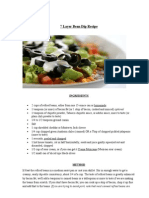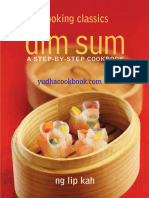Steak Info
Steak Info
Uploaded by
David LakeCopyright:
Available Formats
Steak Info
Steak Info
Uploaded by
David LakeCopyright
Available Formats
Share this document
Did you find this document useful?
Is this content inappropriate?
Copyright:
Available Formats
Steak Info
Steak Info
Uploaded by
David LakeCopyright:
Available Formats
An Illustrated Guide to Tender Steaks
There are a lot of steaks to choose from, which can make things very confusing. Heres exactly what you get for your money when you buy each particular steak.
BY DAWN YANAGIHARA WITH JOHN WILLOUGHBY
Its not easy to select a steak from the supermarket meat case. Steaks come in all different shapes and sizes, are sold at varying prices, and are often slapped with bold, bright Great for Grilling stickers that vie for your attention. To further confuse matters, steak cuts often go by different regional names. Consequently, turning to cookbooks is sometimes of no help, and asking a supermarket butcher for a steak by name can result in frustration. Marketers have also invented fanciful names for different steaks, further muddying the water. Here we try to make sense of it all. We identify the most common tender steaks found in the supermarket, explain what section of the steer each comes from, and advise you about its qualities and most common aliases. We also rate the steak cuts for tenderness and flavor ( being best) and cost ($$$$ being most expensive). The term steak refers to any thin cut of meat, but not all steaks are suitable for quick high-heat grilling, searing, or pan-frying. Here we limit ourselves to those steaks that are best suited for a quick sear in a hot pan or a sizzling stint on a grill. We have not included hanger and skirt steaks, both of which we like, because they are almost impossible to find in grocery stores. London broil is often gone missing, too, but for a different reason: London broil is not a particular type of steak but a method of cooking and cutting the meat. If you see steak in the supermarket that is labeled London Broil, it may be anything from a shoulder steak to a top round steak. Making the Grade There are eight USDA (U.S. Department of Agriculture) beef grades, but most everything available to consumers falls into the top three: Prime, Choice, and Select. The grades classify the meat according to fat marbling and age, which are relatively accurate predictors of palatability; they have nothing to do with freshness or purity. Grading is strictly voluntary on the part of the meat packer. If it is graded, the meat should bear a USDA stamp indicating the grade, but it may not be visible. Ask the butcher when in doubt. In our blind tasting of rib-eye steaks from all three grades, Prime ranked first for its tender, buttery texture and rich beefy flavor; it was discernibly fattier. Choice came in second, with solid flavor and a little more chew. The Select steak was tough and stringy, with flavor that was only acceptable. The lesson here is this: when youre willing to splurge, a Prime steak is worth the money, but a Choice steak that exhibits a moderate amount of marbling is a fine and more affordable option.
CONSUMER BEEF GRADES
CHARACTERISTICS OF PRIMAL CUT STEAKS
CH U CK / S H O U L D E R RIB S H O RT L O I N SIRLOIN RO U N D
Prime
BRISKET/SHANK
Prime meat is heavily marbled with intramuscular fat, which makes for a tender, flavorful steak. A very small percentage (about 2 percent) of graded beef is graded Prime. Prime meats are most often served in restaurants or sold in high-end grocery stores and butcher shops.
P L AT E
FLANK
Chuck Steaks The chuck section, or shoulder area, Choice
The majority of graded beef is graded Choice. Choice beef is moderately marbled with intramuscular fat, but within the category there are varying levels of marbling.
includes ribs 1 through 5 as well as the shoulder blade bone. Most steaks cut from the chuck area are not suitable for grilling or quick high-heat cookingsome chuck steaks are downright tough and others may contain unpleasant amounts of gristle and fat.
tenderloin, renowned for its buttery texture, extends through the short loin and is found in the T-bone and porterhouse steaks that are cut from this section.
Sirloin Steaks The sirloin section is just behind the
Rib Steaks The rib section is located just behind the
Select
chuck, or shoulder area, and contains ribs 6 through 12. Its claim to fame is the prime rib roast. The steaks from the rib section are of high quality, with a rich, smooth texture and pockets of fat in the meat.
short loin section and is sometimes referred to as the hip area. Sirloin steaks are fairly large but thin, and the meat is only moderately tender with decent flavor. The meat tends to be lean and rather dry, but it is a good value.
Flank Steak The flank is located on the underside
Select beef has little marbling. The small amount of intramuscular fat can make Select meats drier, tougher, and less flavorful than the two higher grades.
Short Loin Steaks The short loin section is located
behind the rib section, in the middle area of the back. Steaks cut from the short loin are of very high quality. The
COOKS
belly area, directly below the short loin and sirloin. Steaks from this section have a rich, beefy flavor but must be sliced thinly and on the bias to counteract their chewy texture and long grain.
16
ILLUSTRATED
CHUCK STEAK
TENDERNESS FLAVOR COST
Top Blade
$
rib section, contain large pockets of fat and have a rich, smooth texture. Rib eye is often known as Spencer steak in the West and Delmonico steak in New York. SHORT LOIN STEAKS
TENDERNESS FLAVOR COST
T-Bone
$$$
Top Loin
TENDERNESS FLAVOR COST
$$$
( These small steaks are cut from
to the rear of the steer, they are pin- or hip-bone steak, flat-bone steak, roundbone steak, and wedge-bone steak. Of these, the round bone is best; the others are rarely found in supermarkets. Shell sirloin steak is simply a round-bone sirloin steak that has had the small piece of tenderloin removed. It is most commonly found in the Northeast and is sometimes called New York sirloin. Do not confuse sirloin steaks with the superior top loin steak, which is sometimes called sirloin strip steak.
the shoulder area of the cow. Top blade steaks are tender, but each has a line of gristle running down the center. They are inexpensive and perfectly suited to grilling or sauting. Top blade steak is often called flatiron steak or blade steak. RIB STEAKS
( The T-shaped bone in this steak sep( This long, narrow, triangular steak
TENDERNESS FLAVOR COST
Rib
$$$
may be sold bone-in or boneless. Its most common bone-in alias is shell steak. Boneless top loin is also known as strip steak, hotel steak, sirloin strip steak (dont be confusedits not cut from the sirloin, see below), Kansas City strip, and New York strip. The top loin steak is a bit chewy, with a noticeable grain, and is slightly less fatty than the rib or rib-eye steak.
arates the long, narrow strip of top loin and a small piece of tenderloin. Since it contains top loin and tenderloin meat, the T-bone is well balanced for texture and flavor.
TENDERNESS FLAVOR COST
Top Sirloin
$
TENDERNESS FLAVOR COST
Porterhouse
$$$
( This steak is merely a boneless shell
TENDERNESS FLAVOR COST
Tenderloin
$$$$
sirloin steak. It is sometimes sold as boneless sirloin butt steak or top sirloin butt center cut steak. Again, do not confuse this steak with top loin steak, which is sometimes called sirloin strip steak. FL ANK STEAK
Flank ( Imagine a prime rib roast at a hotel
TENDERNESS
buffet or banquet. A rib steak is a steak cut from that rib roast, with the curved rib bone attached. Rib steaks are less prevalent than the boneless version, the rib eye.
( The porterhouse is really just a huge ( The tenderloin, a long, cylindrical
FLAVOR COST
$$
TENDERNESS FLAVOR COST
Rib Eye
$$$
( A rib-eye steak is a rib steak with
the bone removed. Sans bone, the steak has an oval shape with a narrow strip of meat that curves around one end. Ribeye steaks, like other steaks from the
muscle that is the most tender meat on the cow, may be cut into a number of different steaks, each of which has its own name but all of which are very expensive, since Americans prize tenderness above all else in their steaks. Chateaubriand is a 3-inch-thick steak cut from the thickest part of the tenderloin, usually large enough to serve two. Filet, filet mignon, or tenderloin steak is typically 1 to 2 inches thick, cut from the narrow end of the tenderloin. Tournedos are the smallest tenderloin steaks, about an inch thick, cut toward the tip end. Tenderloin steaks are extremely tender but are not known for having much beefy flavor.
&
T-bone steak with a larger tenderloin section. It is cut farther back in the animal than the T-bone steak. Like the T-bone, the porterhouse, with both top loin and tenderloin sections, has well-balanced flavor and texture. SIRLOIN STEAKS
Round-Bone or Shell Sirloin
TENDERNESS FLAVOR COST
(Flank steak is a large, thin, flat cut
with a distinct longitudinal grain. To minimize the stringy, chewy nature of flank steak, it should not be cooked past medium and should always be sliced thinly across the grain. It is usually sold whole, athough some grocery stores package flank steaks cut into smaller portions. Flank steak is sometimes called jiffy steak.
Illustration: John Burgoyne
( Several steaks are cut from the sirloin,
2000
or hip, section; moving from the front
MAY
JUNE
17
You might also like
- Engine Manual 6HK1 PDFDocument238 pagesEngine Manual 6HK1 PDFArfan Arfiant100% (9)
- AudiDocument2 pagesAudiMarija ZarubicaNo ratings yet
- Chicken Fry RecipeDocument5 pagesChicken Fry RecipeWinning FireNo ratings yet
- The Ashoka Cookbook by Sanjay MajhuDocument87 pagesThe Ashoka Cookbook by Sanjay MajhuMarcel SantosNo ratings yet
- Struthers, J. Keith-Clinical Microbiology-CRC Press (2018)Document299 pagesStruthers, J. Keith-Clinical Microbiology-CRC Press (2018)Rosantia Sarassari100% (9)
- Diploma in Management: Matriculation No: Identity Card No.: Telephone No.: E-Mail: Learning CentreDocument8 pagesDiploma in Management: Matriculation No: Identity Card No.: Telephone No.: E-Mail: Learning CentreSobanah ChandranNo ratings yet
- (: Subtitle) : Dissertation TitleDocument18 pages(: Subtitle) : Dissertation TitleNang Aye PhyuNo ratings yet
- Magic of SteakDocument18 pagesMagic of SteakrajurkarhNo ratings yet
- Steak Boot CampDocument7 pagesSteak Boot CampjmlinaricNo ratings yet
- L1 - Fp4-MeatDocument51 pagesL1 - Fp4-MeatMA.ISABEL CHICONo ratings yet
- Biltong: Biltong Is A Form of Dried, Cured Meat That Originated in SouthernDocument7 pagesBiltong: Biltong Is A Form of Dried, Cured Meat That Originated in SouthernAnonymous E4Rbo2sNo ratings yet
- Sandwiches For MenDocument97 pagesSandwiches For MendevmohnNo ratings yet
- The Wonton Cookbook 50 Delicious Wonton and Asian Dumpling Recipes (2nd Edition) (BookSumo Press) (Z-Library)Document98 pagesThe Wonton Cookbook 50 Delicious Wonton and Asian Dumpling Recipes (2nd Edition) (BookSumo Press) (Z-Library)Mourad AyariNo ratings yet
- Grilling Savant Recipe BookDocument7 pagesGrilling Savant Recipe BookCoogan BluffNo ratings yet
- The Ultimate Steak Cookbook - 120 Steak Recipes Easy and Delicious MouthwateringDocument162 pagesThe Ultimate Steak Cookbook - 120 Steak Recipes Easy and Delicious MouthwateringSantiago Teixeira67% (3)
- Korean Fried ChickenDocument3 pagesKorean Fried ChickenJohnrey TesoroNo ratings yet
- Recipe: Chicken Chowder IngredientsDocument9 pagesRecipe: Chicken Chowder IngredientsLetsirk Dayap EselanamNo ratings yet
- Beef Jerky MachineDocument26 pagesBeef Jerky Machinemr.jake0892No ratings yet
- Iowa State University Football Athlete Cook BookDocument222 pagesIowa State University Football Athlete Cook BookAaron MclatcherNo ratings yet
- ItalianDocument29 pagesItalianFarzana AlamNo ratings yet
- Appetizers 7 Layer Bean Dip Recipe: IngredientsDocument15 pagesAppetizers 7 Layer Bean Dip Recipe: IngredientsJuan Miguel AlvarezNo ratings yet
- 88 Pork Meatloaf Recipes - Best Pork Meatloaf Cookbook For Dummies - PDF RoomDocument168 pages88 Pork Meatloaf Recipes - Best Pork Meatloaf Cookbook For Dummies - PDF RoomEmmaNo ratings yet
- Imam Bayeldi (Eggplant Appetizer) Vospapur (Armenian Lentil and Spinach Soup)Document4 pagesImam Bayeldi (Eggplant Appetizer) Vospapur (Armenian Lentil and Spinach Soup)CAMELLIANo ratings yet
- MM Italian Cheese Kit BookletDocument12 pagesMM Italian Cheese Kit BookletRonak RawatNo ratings yet
- Backyard BBQ Favorites Cookbook 1Document16 pagesBackyard BBQ Favorites Cookbook 1Ivan Dos SantosNo ratings yet
- How To Make Korean Fish CakesDocument7 pagesHow To Make Korean Fish CakesPutri SafitriNo ratings yet
- Beef Cuts Poster 4047 PDFDocument1 pageBeef Cuts Poster 4047 PDFKenesaNo ratings yet
- Grilled Rib Eye Steak Recipe, Reverse Sear - ThermoWorksDocument11 pagesGrilled Rib Eye Steak Recipe, Reverse Sear - ThermoWorksBarba BranimirNo ratings yet
- Shrimp-Magic The First 5Document15 pagesShrimp-Magic The First 5jdfeka100% (1)
- Kenyan RecipesDocument6 pagesKenyan RecipesLinnea KulunduNo ratings yet
- Recipes For SuccessDocument48 pagesRecipes For SuccessyannnetnetNo ratings yet
- Get Ready For Grilling Season With Bobby Flay!Document18 pagesGet Ready For Grilling Season With Bobby Flay!Simon and SchusterNo ratings yet
- 2008 CookbookDocument54 pages2008 CookbookMeridee Mannino100% (2)
- Chang Good FoodDocument68 pagesChang Good Foodwilkied100% (1)
- A Taste of ThaiDocument11 pagesA Taste of Thaiatotreno5998No ratings yet
- Liquids (And Herbs and Spices)Document14 pagesLiquids (And Herbs and Spices)Patrick LucañasNo ratings yet
- Classic 1000 Chinese RecipesDocument1,487 pagesClassic 1000 Chinese Recipesethemhunt100% (1)
- India RecipesDocument74 pagesIndia RecipesKeman Daao100% (1)
- A Literature Review On Supply Chain Management EvolutionDocument7 pagesA Literature Review On Supply Chain Management EvolutionHarish VenkatasubramanianNo ratings yet
- Techniques BBQDocument26 pagesTechniques BBQMarcel SantosNo ratings yet
- Catering Menu: All NaturalDocument16 pagesCatering Menu: All NaturalRohit MalviyaNo ratings yet
- 1001 One Pot, Casseroles, Soups & Stewes PDFDocument7 pages1001 One Pot, Casseroles, Soups & Stewes PDFENACHE GEORGETA0% (1)
- Final Paper Business ProposalDocument26 pagesFinal Paper Business ProposalJames Raymond CruzNo ratings yet
- Boar's Head Brands Recipe BookDocument27 pagesBoar's Head Brands Recipe BookJo DaleyNo ratings yet
- The Art of Making SushiDocument16 pagesThe Art of Making SushiSNo ratings yet
- Florida Keys & Key West Chef's Table Extraordinary Recipes From The Conch RepublicDocument225 pagesFlorida Keys & Key West Chef's Table Extraordinary Recipes From The Conch RepublicSTINGBULLNo ratings yet
- Italian Cooking ManualDocument29 pagesItalian Cooking ManualScribdTranslationsNo ratings yet
- Sub Sandwich Ideas - Google Search 2Document1 pageSub Sandwich Ideas - Google Search 2Zandra Sibiya AndersonNo ratings yet
- Beef Cuts - Com ADocument6 pagesBeef Cuts - Com APatetteNo ratings yet
- Cooking Techniques - How To Cook Like A Chef (Chinese) in Just One DayDocument46 pagesCooking Techniques - How To Cook Like A Chef (Chinese) in Just One DayEduardo Luis DouradoNo ratings yet
- Chicken and Spinach SoupDocument1 pageChicken and Spinach SoupCTaylor0120No ratings yet
- BeefDocument12 pagesBeefTheamicable Firstlady MarNo ratings yet
- Flavor God Garlic Herb Salt Recipe BookDocument25 pagesFlavor God Garlic Herb Salt Recipe BookAmanda SaracenoNo ratings yet
- Cooking Classics - Dim Sum - A Step-By-Step CookbookDocument121 pagesCooking Classics - Dim Sum - A Step-By-Step CookbookCozinha do Freitas100% (1)
- Barilla Modern Family Cookbook WebDocument15 pagesBarilla Modern Family Cookbook WebOrza MariaNo ratings yet
- Biltong (Meso Suseno Na Vazduhu)Document12 pagesBiltong (Meso Suseno Na Vazduhu)kojot-bg2640No ratings yet
- Gone Fishin 45 Easy Fish Recipes For Salmon Tuna Shellfish MoreDocument50 pagesGone Fishin 45 Easy Fish Recipes For Salmon Tuna Shellfish Morejoe100% (2)
- Asian Slaw - Crunchy Oriental Cabbage Salad With Asian Dressing - RecipeTin EatsDocument2 pagesAsian Slaw - Crunchy Oriental Cabbage Salad With Asian Dressing - RecipeTin EatsGrace VersoniNo ratings yet
- Anthony Bourdain - Quotes Collection: Biography, Achievements And Life LessonsFrom EverandAnthony Bourdain - Quotes Collection: Biography, Achievements And Life LessonsNo ratings yet
- Quick & Easy Hot Sandwiches - Sizzling, Savory, Oozing, & SultryFrom EverandQuick & Easy Hot Sandwiches - Sizzling, Savory, Oozing, & SultryNo ratings yet
- Mock Test MSDocument4 pagesMock Test MSrita sehgalNo ratings yet
- Mariners Role in Collecting Evidence Handbook North of England MemberDocument70 pagesMariners Role in Collecting Evidence Handbook North of England MemberИрина Арбатманова100% (1)
- 6 Pricing Understanding and Capturing Customer ValueDocument27 pages6 Pricing Understanding and Capturing Customer ValueShadi JabbourNo ratings yet
- Amaanat: DefinitionDocument5 pagesAmaanat: DefinitionAltaf AhmadNo ratings yet
- Perforation Varieties Can Make The DifferenceDocument4 pagesPerforation Varieties Can Make The DifferenceSabah SalihNo ratings yet
- Hindustan Unilever Limited: Powerpoint Presentation of Company Law OnDocument34 pagesHindustan Unilever Limited: Powerpoint Presentation of Company Law OnNavya AroraNo ratings yet
- IRS Form 1040Document2 pagesIRS Form 1040fox43wpmt50% (2)
- 5.3 Banco Nacional de Cuba v. Sabbatino - 376 U.S. 398 (1964) SyllabusDocument5 pages5.3 Banco Nacional de Cuba v. Sabbatino - 376 U.S. 398 (1964) SyllabusashNo ratings yet
- Time The Obligation To Deliver It Arises. However, He ShallDocument5 pagesTime The Obligation To Deliver It Arises. However, He ShallKryzia RillorazaNo ratings yet
- Home Assignment 02: Total Sales Value Variable Costs Fixed Costs Annual Savings 1175000 1175000 1175000 1175000 1175000Document2 pagesHome Assignment 02: Total Sales Value Variable Costs Fixed Costs Annual Savings 1175000 1175000 1175000 1175000 1175000Farzan Yahya HabibNo ratings yet
- Isuzu Transmission AW30 40LE Model Workshop ManualDocument266 pagesIsuzu Transmission AW30 40LE Model Workshop ManualjuanNo ratings yet
- Autopilot: SeriesDocument7 pagesAutopilot: Seriestolma4vNo ratings yet
- School of Cinematic Arts: SyllabusDocument8 pagesSchool of Cinematic Arts: SyllabusnnnnnatNo ratings yet
- Pepperfry: Omnichannel Supply ChainDocument16 pagesPepperfry: Omnichannel Supply Chainsheersha kkNo ratings yet
- Makalah HTN KolombiaDocument130 pagesMakalah HTN Kolombiaaurelio liandoNo ratings yet
- Quantitative Models (Chp10)Document22 pagesQuantitative Models (Chp10)Ruchika VermaNo ratings yet
- Fast Parts Guides - MFDocument45 pagesFast Parts Guides - MFbaltazar1017100% (1)
- Critical Analysis of Mental Health Care ActDocument11 pagesCritical Analysis of Mental Health Care ActDeepshikha UghadeNo ratings yet
- Swot To TowsDocument16 pagesSwot To Towsmanochm100% (2)
- On A Generalization of Smoluchowski's Diffusion EquationDocument4 pagesOn A Generalization of Smoluchowski's Diffusion EquationDanieleRinaldoNo ratings yet
- Location: Taman Lestari Putra, Bandar Putra PermaiDocument12 pagesLocation: Taman Lestari Putra, Bandar Putra PermaiisbolatiNo ratings yet
- Date: Grade/Section: Teacher: Subject: Activity NoDocument10 pagesDate: Grade/Section: Teacher: Subject: Activity Noarlyn villanuevaNo ratings yet
- Orig Business Plan - Isagani Crispy Pasta OriginalDocument17 pagesOrig Business Plan - Isagani Crispy Pasta OriginalGilbert FernandoNo ratings yet
- Basic Principles of Biofiltration and System Design PDFDocument18 pagesBasic Principles of Biofiltration and System Design PDFveliger2009No ratings yet
- Request For Relevant MaterialDocument1 pageRequest For Relevant Materialsandra kivedoNo ratings yet

























































































